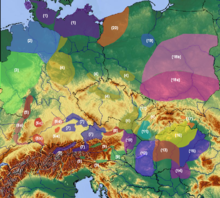Straubing culture
| Alternative names | Straubingen culture |
|---|---|
| Geographical range | Southern Germany |
| Period | Bronze Age |
| Dates | c. 2150 — 1700/1500 BC |
| Preceded by | Bell Beaker culture |
| Followed by | Tumulus culture |

The Straubing culture (or Straubingen culture) is the name for a Bronze Age culture which spread primarily in the territory of modern-day Lower Bavaria and Upper Austria between the 22nd to 16th centuries BC.
The Straubingen culture was part of the Northern Alpine EBA, which is classified as the western-most part of the Danubian EBA which was extended from the Rhine Valley in the west to Upper Austria in the East.[1] It was recognized as an autonomous culture by Karl Schumacher in 1917.
Characteristics[edit]
Economy[edit]
The economy was sustained mainly by agriculture and the herding of diverse animal species. Important was also the metallurgic sector.
Dwellings[edit]
Hamlets constituted by one or two long-houses placed west of their graveyards. The houses were made of wood, with a North-South orientation; basically were longhouses composed by one or two naves.
Burials[edit]
The burial practices continued the Bell Beaker Culture rites involving sex-differentiated body positioning in a crouched position as with the orientation of the tomb. Some objects found with buried individuals were bronze daggers, bracelets, and even objects made of amber.
Genetic profile[edit]
Y-DNA analysis with enough genetic coverage was obtained from 21 male individuals buried in the Lech valley, five sampled individuals had derived alleles placing them on the lineage spanning R1b-M269 to R1b-L11/P310, but were not covered at P312/S116; 15 sampled males had the subvariant R1b-P312/S116* (with no more derived alleles further downstream called). There was only a male from the I clade. The autosomal composition detected was ~13% Western HG, ~47% Anatolian farmer, ~38% Yamnaya.[1]
Gallery[edit]
Bibliography[edit]
- Gustav Behrens: Straubinger Stufe. In: Max Ebert (Hrsg.): Reallexikon der Vorgeschichte. Band 12: Seedorfer Typus – südliches Afrika. de Gruyter, Berlin 1928, S. 460.
- Hans-Jürgen Hundt: Katalog Straubing. Band 1: Hans-Jürgen Hundt: Die Funde der Glockenbecher-Kultur und der Straubinger Kultur (= Materialhefte zur bayerischen Vorgeschichte. Bd. 11, ZDB-ID 534018-4). Lassleben, Kallmünz/Oberpfalz 1958.
- Birgit Lißner: Zu den frühbronzezeitlichen Gruppen in Süddeutschland. In: Leipziger online-Beiträge zur ur- und frühgescheschichtlichen Archäologie. Bd. 13, 2004, ISSN 1612-4227, S. 69–88, online (PDF; 655 KB) Archived 2014-03-22 at the Wayback Machine.
- Karl H. Rieder: Archäologie um Ingolstadt. Ergebnisse der letzten 3 Jahre. Ausstellung des Landesamtes für Denkmalpflege. 5.–27. November 1983. Historischer Verein, Ingolstadt 1983.
- Angelika Wegener-Hüssen, Gerd Riedel (Red.): Ingolstadt und der oberbayerische Donauraum (= Führer zu archäologischen Denkmälern in Deutschland. Bd. 42). Theiss, Stuttgart 2003, ISBN 3-8062-1716-5.
See also[edit]
Notes[edit]
- ^ a b Mittnik, Alissa; Massy, Ken; Knipper, Corina; Wittenborn, Fabian; Friedrich, Ronny; Pfrengle, Saskia; Burri, Marta; Carlichi-Witjes, Nadine; Deeg, Heidi; Furtwängler, Anja; Harbeck, Michaela; von Heyking, Kristin; Kociumaka, Catharina; Kucukkalipci, Isil; Lindauer, Susanne; Metz, Stephanie; Staskiewicz, Anja; Thiel, Andreas; Wahl, Joachim; Haak, Wolfgang; Pernicka, Ernst; Schiffels, Stephan; Stockhammer, Philipp W.; Krause, Johannes (8 November 2019). "Kinship-based social inequality in Bronze Age Europe". Science. 366 (6466): 731–734. doi:10.1126/science.aax6219.


 French
French Deutsch
Deutsch
